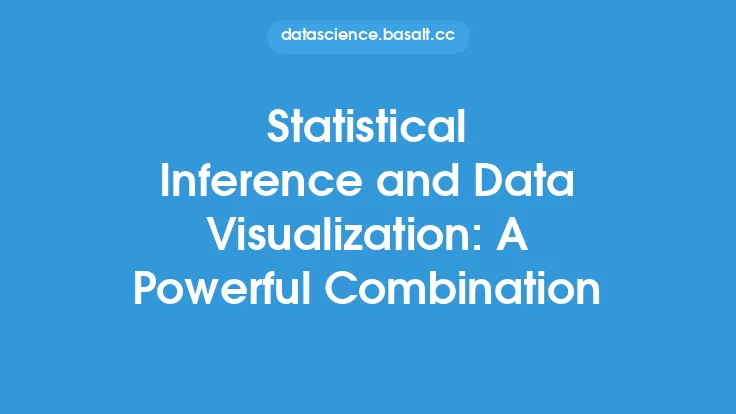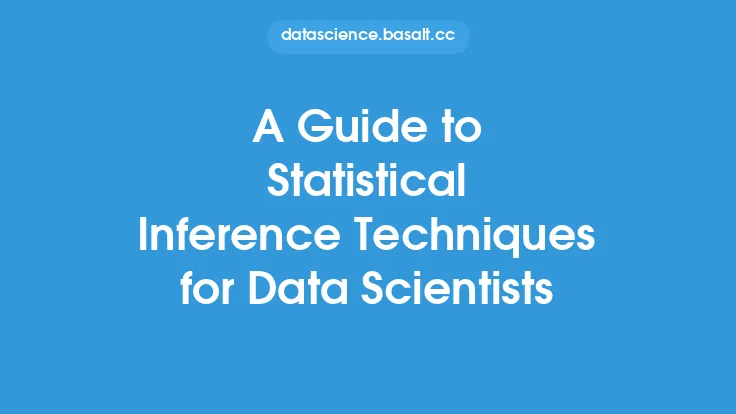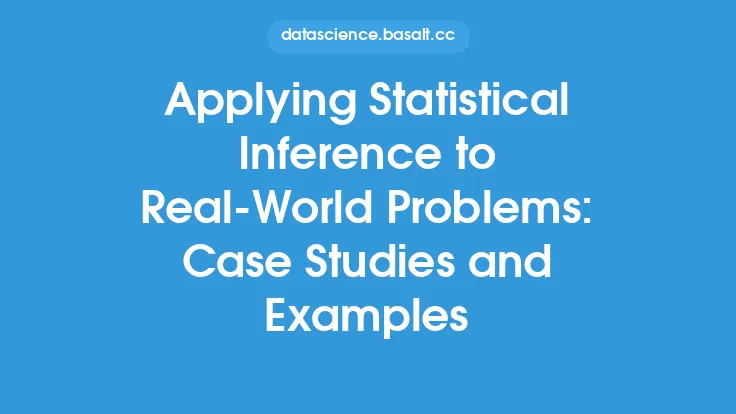Statistical inference is a crucial aspect of data analysis, as it enables researchers and data scientists to draw conclusions about a population based on a sample of data. The goal of statistical inference is to make informed decisions about a population by analyzing a representative sample of data. However, statistical inference can be a complex and nuanced field, and there are many best practices and common pitfalls that data analysts should be aware of.
Introduction to Statistical Inference
Statistical inference involves using statistical methods to make conclusions about a population based on a sample of data. This can include estimating population parameters, testing hypotheses, and constructing confidence intervals. Statistical inference is a critical component of data analysis, as it allows researchers to make informed decisions about a population based on a limited sample of data. There are several key concepts that underlie statistical inference, including probability, sampling distributions, and statistical models.
Best Practices for Statistical Inference
There are several best practices that data analysts should follow when performing statistical inference. First, it is essential to ensure that the sample of data is representative of the population. This can be achieved by using random sampling methods, such as simple random sampling or stratified sampling. Additionally, data analysts should be aware of potential sources of bias, such as selection bias or information bias, and take steps to mitigate these biases. Another best practice is to use appropriate statistical models and techniques, such as linear regression or hypothesis testing, to analyze the data. Finally, data analysts should always interpret the results of statistical inference in the context of the research question or problem being addressed.
Common Pitfalls in Statistical Inference
There are several common pitfalls that data analysts should be aware of when performing statistical inference. One of the most significant pitfalls is the failure to account for sampling error. Sampling error occurs when the sample of data is not representative of the population, and it can lead to biased or inaccurate conclusions. Another common pitfall is the misuse of statistical tests, such as using a t-test when the data are not normally distributed. Data analysts should also be aware of the problem of multiple testing, which occurs when multiple statistical tests are performed on the same data set. This can lead to an increased risk of Type I errors, which can result in false positives. Finally, data analysts should be cautious when interpreting the results of statistical inference, as the results may not always be generalizable to the population.
Statistical Models and Techniques
There are several statistical models and techniques that are commonly used in statistical inference. One of the most widely used models is linear regression, which is used to model the relationship between a dependent variable and one or more independent variables. Another commonly used technique is hypothesis testing, which is used to test a hypothesis about a population parameter. Data analysts may also use confidence intervals to estimate a population parameter, such as a mean or proportion. Additionally, data analysts may use statistical models, such as logistic regression or decision trees, to classify observations into different categories.
Probability and Sampling Distributions
Probability and sampling distributions are fundamental concepts in statistical inference. Probability refers to the chance or likelihood of an event occurring, and it is often expressed as a numerical value between 0 and 1. Sampling distributions, on the other hand, refer to the distribution of a statistic, such as the mean or standard deviation, across multiple samples of data. Understanding probability and sampling distributions is critical in statistical inference, as they provide the foundation for making conclusions about a population based on a sample of data. Data analysts should be familiar with the different types of probability distributions, such as the normal distribution or binomial distribution, and how to use these distributions to model real-world phenomena.
Interpreting Results
Interpreting the results of statistical inference is a critical step in the data analysis process. Data analysts should always interpret the results in the context of the research question or problem being addressed. This includes considering the practical significance of the results, as well as the statistical significance. Data analysts should also be aware of the limitations of the study, including any potential sources of bias or error. Additionally, data analysts should consider the generalizability of the results to the population, and whether the results can be applied to other contexts or populations.
Avoiding Common Mistakes
There are several common mistakes that data analysts should avoid when performing statistical inference. One of the most significant mistakes is the failure to check the assumptions of a statistical test or model. This can lead to biased or inaccurate conclusions, and can result in incorrect decisions being made. Another common mistake is the misuse of statistical terminology, such as using the term "significant" to refer to practical significance rather than statistical significance. Data analysts should also avoid over-interpreting the results of statistical inference, and should be cautious when making conclusions about a population based on a limited sample of data.
Advanced Topics in Statistical Inference
There are several advanced topics in statistical inference that data analysts may encounter. One of the most significant topics is Bayesian inference, which is a statistical framework that uses Bayes' theorem to update the probability of a hypothesis based on new data. Another advanced topic is bootstrapping, which is a resampling method that can be used to estimate the variability of a statistic or to construct confidence intervals. Data analysts may also encounter advanced statistical models, such as generalized linear mixed models or machine learning algorithms, which can be used to analyze complex data sets.
Conclusion
Statistical inference is a critical component of data analysis, and it provides a framework for making informed decisions about a population based on a sample of data. By following best practices, avoiding common pitfalls, and using appropriate statistical models and techniques, data analysts can ensure that their conclusions are accurate and reliable. Additionally, data analysts should always interpret the results of statistical inference in the context of the research question or problem being addressed, and should be aware of the limitations of the study. By doing so, data analysts can unlock the full potential of statistical inference and make meaningful contributions to their field.





